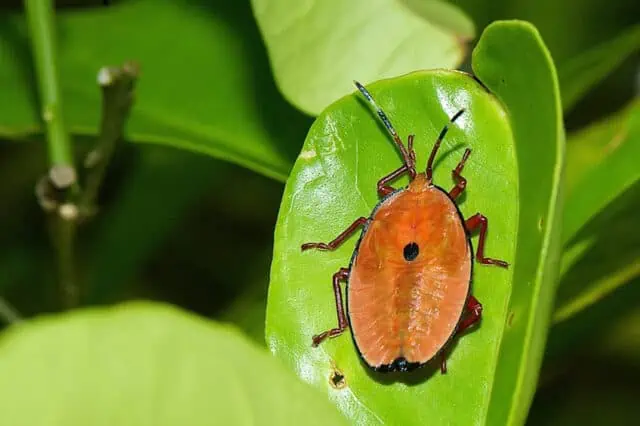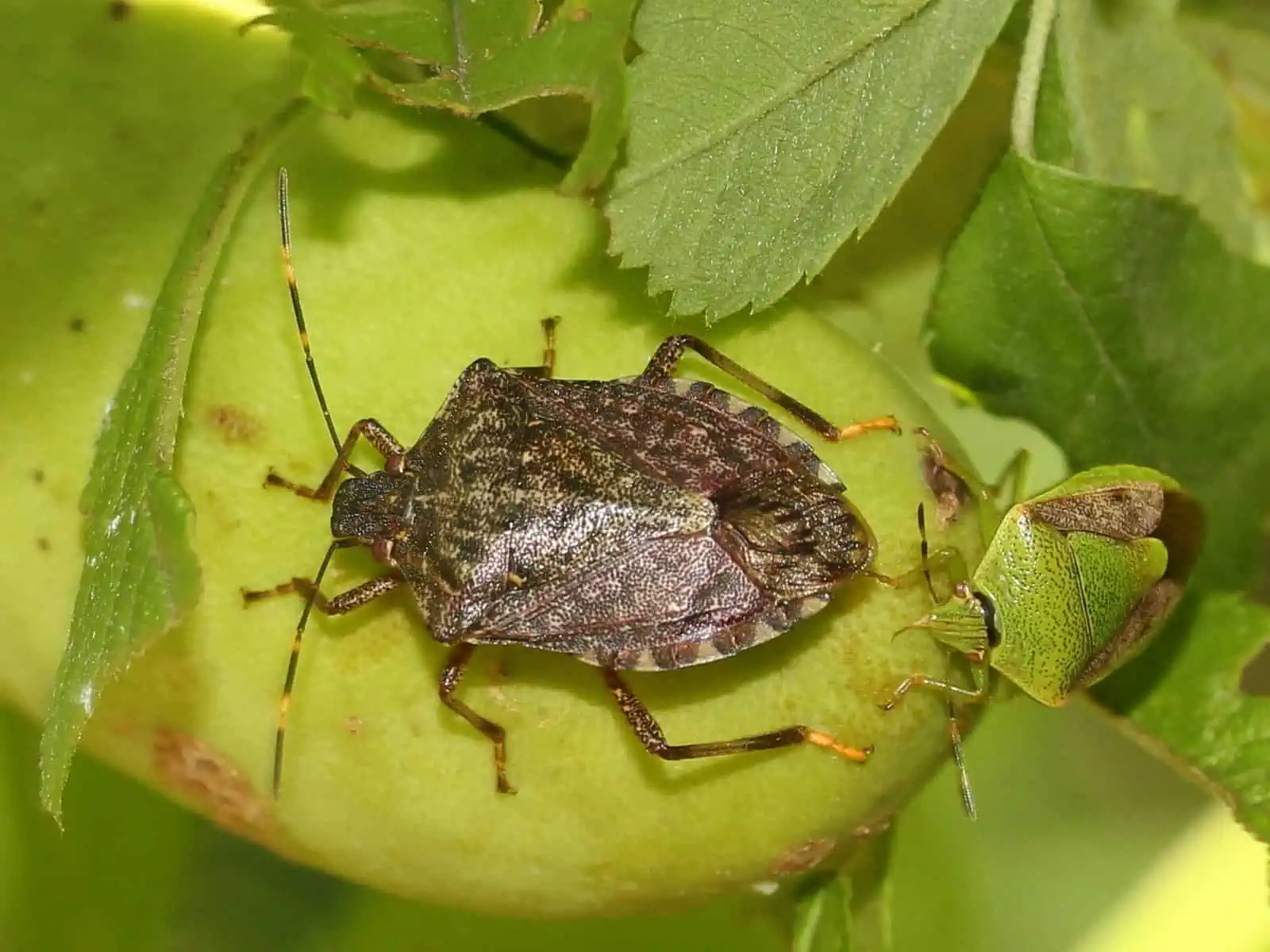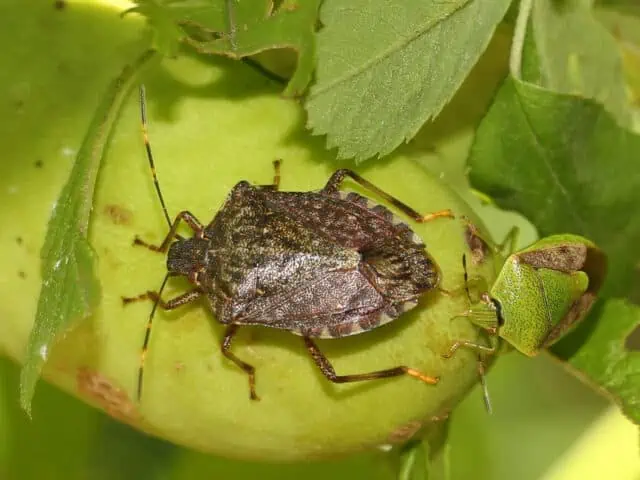Leopard geckos can indeed eat stink bugs, but there are certain considerations and precautions to keep in mind. Stink bugs, as their name suggests, have a distinct odor and chemical defenses that might deter some predators. However, for leopard geckos, these insects can be a part of their diverse diet.
Can Leopard Geckos Eat Stink Bugs?
Yes, leopard geckos can consume stink bugs, but it’s not as straightforward as simply offering them up. While these insects can be a tempting snack due to their availability in certain regions, they come with their own set of challenges. Stink bugs have evolved chemical defenses to ward off predators, and these very defenses can influence a gecko’s decision to eat them.
Why Do They Eat Stink Bugs?

Leopard geckos, like many reptiles, have evolved to be opportunistic feeders. This means they often eat what’s available in their environment, adapting their diet based on the prey they encounter. Stink bugs, being common in certain habitats, naturally become a part of this menu. The potential benefits of consuming stink bugs include their nutritional value, which can be a good source of protein and other essential nutrients for the gecko.
| Fact | Detail |
|---|---|
| Diet Type | Opportunistic feeders |
| Common Prey | Insects, including stink bugs |
| Benefits of Stink Bugs | Nutritional value, protein source |
However, stink bugs aren’t just a walk in the park for predators like the leopard gecko. These bugs have developed chemical defenses as a survival mechanism. When threatened, stink bugs release a pungent odor, which is a result of the chemicals they produce. This odor is not just for show—it can deter many potential predators, making them think twice before making a meal out of the bug.
Yet, for leopard geckos, the nutritional value of stink bugs might outweigh the off-putting smell. These insects can offer a unique nutrient profile, providing essential vitamins and minerals that contribute to the overall health of the gecko.
| Stink Bug Defense | Effect on Predators |
|---|---|
| Chemical Production | Releases pungent odor |
| Deterrence | Many predators are repelled by the smell |
| Nutritional Value for Geckos | High protein, vitamins, and minerals |
What Types of Stink Bugs Will Leos Eat?
Stink bugs come in a variety of species, each with its own unique characteristics and nutritional profile. While leopard geckos might encounter several of these species in their natural habitats, not all stink bugs are created equal in the eyes of these reptiles. Some insects might be more palatable, while others could pose potential risks.
Green Stink Bug
The Green Stink Bug, scientifically known as Chinavia hilaris, is a common insect found in various regions. As its name suggests, its primary appearance feature is its vibrant green color, which allows it to blend seamlessly with plants and crops. Typically measuring between 12 to 17 mm in length, this bug has a shield-like shape, characteristic of stink bugs.
| Characteristic | Detail |
|---|---|
| Color | Vibrant green |
| Size | 12-17 mm |
| Shape | Shield-like |
In terms of habitat, the Green Stink Bug is often found in gardens, fields, and forests, primarily in North America. Their feeding habits revolve around sucking the sap from plants, making them a potential pest for various crops. This diet rich in plant nutrients might translate into a nutritious meal for predators like the leopard gecko.
However, feeding Green Stink Bugs to leopard geckos comes with its considerations. While they can offer nutritional benefits due to their plant-based diet, there’s also a potential risk. These bugs, when feeding on pesticide-treated plants, might carry traces of these chemicals. Consuming such bugs could introduce these harmful substances into the gecko’s system.
| Feeding Habit | Impact |
|---|---|
| Sap from plants | Potential pest for crops |
| Pesticide ingestion | Health risk for predators |
Brown Marmorated Stink Bug
Originating from Asia, the Brown Marmorated Stink Bug (Halyomorpha halys) has made a significant mark in various parts of the world due to its widespread distribution. One of its most distinguishing characteristics is its dark brown back, contrasted by a creamy white or light brown underbelly. This coloration, combined with its mottled or “marbled” appearance, gives it its name.
| Characteristic | Detail |
|---|---|
| Origin | Asia |
| Color | Dark brown back with creamy white or light brown underbelly |
| Appearance | Mottled or marbled |
The Brown Marmorated Stink Bug’s feeding habits are quite diverse. They feed on a wide range of fruits, vegetables, and other plants, making them a significant concern for many farmers due to the damage they can inflict on crops. Their widespread distribution means they have adapted to various environments, from urban areas to farmlands.
However, when considering them as a potential food source for leopard geckos, there are factors to weigh. On the one hand, their diverse plant-based diet can offer a range of nutrients. On the other, similar to the Green Stink Bug, there’s a risk associated with pesticides. If these bugs have fed on treated plants, they might carry harmful chemicals that could be ingested by the gecko.
| Feeding Habit | Impact |
|---|---|
| Diverse plant diet | Nutritional benefits |
| Potential pesticide ingestion | Health risk for predators |
Western Conifer Seed Bug
The Western Conifer Seed Bug (Leptoglossus occidentalis) might not be the first insect that comes to mind when considering food for leopard geckos, but it holds relevance in the diverse menu of these reptiles. Native to the western part of North America, this bug has expanded its range over the years, making it more accessible to various predators, including leopard geckos.
| Characteristic | Detail |
|---|---|
| Origin | Western North America |
| Relevance to Leopard Geckos | Accessible prey due to expanded range |
In terms of physical appearance, the Western Conifer Seed Bug boasts a relatively large size for a bug, often reaching up to 20 mm in length. It has a brownish body adorned with a distinctive zig-zag pattern on its wings. One of its unique characteristics is the leaf-like expansions on its hind legs, which are quite noticeable and differentiate it from other bugs.
| Physical Appearance | Detail |
|---|---|
| Size | Up to 20 mm |
| Color | Brown with zig-zag pattern on wings |
| Unique Feature | Leaf-like expansions on hind legs |
The habits of the Western Conifer Seed Bug revolve around its preference for coniferous trees. They feed on the sap and seeds of these trees, particularly during their nymph stages. This feeding habit can sometimes lead them to be considered pests, especially when they invade homes seeking warmth during colder months.
For leopard geckos, the Western Conifer Seed Bug can be a nutritious meal option due to its sap and seed diet.
Other Species of Stink Bugs
While we’ve delved into some of the more common stink bug species that leopard geckos might encounter, there are several other species that these reptiles can safely consume. Each species has its own set of characteristics, including distinct odors and potential chemical defenses. Here’s a brief overview of some of these species:
Southern Green Stink Bug (Nezara viridula)
This bug is bright green and is often mistaken for the Green Stink Bug. It’s found in warmer climates and is known to feed on over 30 species of plants.
Odor: Distinctive, pungent smell when threatened.
Harmful Chemicals: Potential for pesticide ingestion if feeding on treated plants.
Red-Shouldered Stink Bug (Thyanta custator)
Recognizable by its green body with red markings on its shoulders. It’s a pest for many fruit crops.
Odor: Mild odor compared to other stink bugs.
Harmful Chemicals: Risk of pesticide exposure due to its preference for fruit crops.
Rice Stink Bug (Oebalus pugnax)
Brownish in color and primarily found in rice fields, as its name suggests.
Odor: Mild odor.
Harmful Chemicals: Potential for chemical ingestion if found in treated rice fields.
Two-Spotted Stink Bug (Perillus bioculatus)
Black and red in color, this bug is a predator of other insects, especially the Colorado potato beetle.
Odor: Less pungent compared to herbivorous stink bugs.
Harmful Chemicals: Lower risk due to its predatory nature.
| Stink Bug Species | Odor | Potential Harmful Chemicals |
|---|---|---|
| Southern Green Stink Bug | Pungent | Pesticides from plants |
| Red-Shouldered Stink Bug | Mild | Pesticides from fruit crops |
| Rice Stink Bug | Mild | Chemicals from rice fields |
| Two-Spotted Stink Bug | Less pungent | Lower risk due to diet |
Health Benefits of Eating Stink Bugs for Leopard Geckos
Stink bugs, despite their off-putting name and reputation, can offer a range of health benefits for leopard geckos. These insects, with their diverse diets and nutritional profiles, can be a valuable addition to a gecko’s menu. From being a rich source of protein to adding variety and preventing nutritional deficiencies, stink bugs can play a pivotal role in ensuring the well-being of these reptiles.
Source of Protein
Protein is a vital component in the diet of leopard geckos, and stink bugs serve as an excellent source of this essential nutrient. These insects, with their varied diets, accumulate a rich protein content that can significantly benefit a gecko’s health and growth.
| Nutrient | Benefit for Leopard Geckos |
|---|---|
| Protein | Supports growth, muscle development, and overall health |
Stink bugs not only offer protein but also contribute to the overall nutritional balance and diversity in a gecko’s diet. Their unique nutrient profile, which includes essential vitamins and minerals, complements other food sources, ensuring that geckos receive a well-rounded intake of nutrients. This diversity in diet is crucial for leopard geckos, as it prevents potential nutritional deficiencies and promotes optimal health.
A balanced diet for leopard geckos isn’t just about one or two food sources. It’s about combining various feeder insects (from cockroaches to snails and slugs), fruits, and vegetables to ensure a comprehensive nutrient intake. Stink bugs, with their high protein content and unique nutrient profile, fit perfectly into this balanced diet approach. When included alongside other food sources, they can help maintain a healthy, diverse, and nutritionally rich diet for these reptiles.
Variety and Balance in Their Diet
Variety and balance are fundamental principles in ensuring the health and longevity of leopard geckos. Just as humans thrive on a diverse diet, these reptiles benefit from a mix of different food sources. A varied diet ensures they receive a broad spectrum of nutrients, preventing deficiencies and promoting overall well-being.
Stink bugs, as we’ve discussed, bring a unique set of nutrients to the table. But they’re just one piece of the puzzle. Different types of insects each have their own nutritional profiles, and when combined, they offer a comprehensive nutrient intake. For instance, while stink bugs might be rich in certain vitamins and minerals, other insects could provide fats or carbohydrates that are equally essential for the gecko’s health.
| Insect | Nutritional Contribution |
|---|---|
| Stink bugs | Protein, vitamins, and minerals |
| Crickets | Protein and essential fats |
| Mealworms | Carbohydrates and fats |
| Dubia roaches | High protein and low fat |
Other live food options that can be incorporated into a leopard gecko’s diet include waxworms, silkworms, and phoenix worms. Each of these options contributes to the gecko’s nutritional diversity, ensuring they receive all the essential nutrients in the right proportions.
Prevention of Nutritional Deficiencies
Ensuring the health and vitality of leopard geckos goes beyond merely feeding them; it’s about providing a diet that prevents nutritional deficiencies. Such deficiencies can lead to a host of health issues, from weakened immune systems to growth abnormalities. Therefore, understanding and implementing a balanced and varied diet is of paramount importance for these reptiles.
Achieving a balanced diet for leopard geckos involves incorporating a diverse range of insects. Each insect species offers a unique nutrient profile, ensuring the gecko receives all the essential vitamins, minerals, and other nutrients. For instance, while one insect might be a rich source of calcium, another could provide essential fatty acids.
Stink bugs, as we’ve highlighted, are an excellent source of protein. Protein is crucial for muscle development, tissue repair, and overall growth in leopard geckos. By incorporating stink bugs into their diet, you’re ensuring they receive this vital nutrient in ample amounts.
| Insect | Primary Nutrient |
|---|---|
| Stink bugs | Protein |
| Crickets | Calcium |
| Mealworms | Fatty acids |
However, relying solely on one insect type can lead to imbalances. It’s the combination of various insects, each with its nutrient offerings, that ensures a comprehensive nutrient intake. This diverse range of insects, with stink bugs being a key component, guarantees the prevention of nutritional deficiencies.
Risks Involved with Feeding Leopard Geckos Stink Bugs
While stink bugs can offer nutritional benefits to leopard geckos, introducing them into the gecko’s diet isn’t without its challenges and risks. One of the most evident concerns is the foul smell these bugs emit. This pungent odor, a defense mechanism, can deter leopard geckos from consuming them. A gecko might be curious initially, but the strong scent can make them hesitant, leading to a refusal to eat.
Another significant risk is the potential presence of parasites or pesticides in the stink bugs. If these insects have been feeding on plants treated with pesticides, they might carry these harmful chemicals in their system. When consumed by the gecko, these chemicals can lead to health complications. Similarly, wild-caught stink bugs might harbor parasites, introducing them to the gecko when ingested.
| Risk | Impact on Leopard Geckos |
|---|---|
| Foul smell | Deterrence from eating |
| Pesticides | Potential health complications |
| Parasites | Introduction of external parasites |
Additionally, some stink bugs possess defensive mechanisms beyond their odor. Sharp mouthparts or spines can pose an injury risk to the gecko during consumption. While these instances are rare, they underscore the importance of sourcing stink bugs responsibly and ensuring they are safe for consumption.
Safety and Handling Tips
Feeding stink bugs to leopard geckos can be a beneficial practice, but it’s essential to do so safely and responsibly. Proper handling and preparation can make a significant difference in ensuring the health and well-being of your gecko. Here are some safety and handling tips to consider:
Be Mindful of the Foul Smell: As their name suggests, stink bugs release a pungent odor, especially when threatened. It’s advisable to handle them gently to avoid triggering this defense mechanism. The strong scent can deter your gecko from eating, so minimizing the release of this odor can increase the chances of successful feeding.
Gut Loading is Essential: Before feeding stink bugs to your gecko, it’s crucial to gut load them. Gut loading is the process of feeding the insects a nutritious diet, ensuring they pass on these nutrients to the gecko when consumed. Feed the stink bugs a mix of fruits and vegetables for at least 24 hours before offering them to your gecko.
| Gut Loading Diet | Benefits |
|---|---|
| Fruits (e.g., apples, oranges) | Vitamins and hydration |
| Vegetables (e.g., carrots, leafy greens) | Essential minerals and fiber |
Source Responsibly: Always ensure that the stink bugs you’re offering haven’t been exposed to pesticides or harmful chemicals. If you’re sourcing them from the wild, ensure they come from areas free from chemical treatments. Alternatively, purchasing from reputable breeders or suppliers can provide assurance of their safety.
Observe Your Gecko: After introducing stink bugs into your gecko’s diet, monitor their behavior and health. If they show signs of distress, discomfort, or refusal to eat, it might be best to reconsider or limit the inclusion of stink bugs in their diet. Other insects, such as spiders, should be a no go from the beginning.






